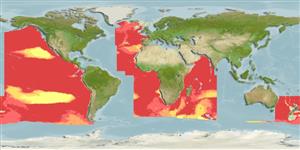>
Lophiiformes (Anglerfishes) >
Oneirodidae (Dreamers)
Etymology: Lophodolos: Greek, 'lopho' or 'lophio' = mane, crest or tuft + Greek, 'dolos' = artifice, deceit or guile (describing a deceitful little fish that beguiles its prey with a baited illicium) (Ref. 86949).
Environment: milieu / climate zone / depth range / distribution range
Ökologie
seewasser bathypelagisch; tiefenbereich 750 - 1625 m (Ref. 26282). Deep-water
Tropical parts of all oceans.
Size / Gewicht / Alter
Maturity: Lm ? range ? - ? cm
Max length : 7.7 cm SL (female)
Kurzbeschreibung
Morphologie | Morphometrie
Rückenflossenweichstrahlen (insgesamt): 6-8; Afterflossenweichstrahlen: 5 - 7. Distinguishing characteristics of metamorphosed female: length of illicium greater than 25% SL in specimens 30 mm and larger; escal bulb width 2.1-4.0% SL in specimens 25 mm and larger; short escal appendages, length 1.2-5.0% SL in specimens 25 mm and larger, 4.2-10.5% SL in specimens less than 25mm; short sphenotic spine, length 1.9-6.0% SL in specimens 30 mm and larger; short quadrate spine, length 1.6-5.0% SL in specimens 30mm and larger (Ref. 86949).
Life cycle and mating behavior
Geschlechtsreife | Fortpflanzung | Ablaichen | Eier | Fecundity | Larven
Bertelsen, E., 1990. Oneirodidae. p. 498-507. In J.C. Quero, J.C. Hureau, C. Karrer, A. Post, and L. Saldanha (eds.) Check-list of the fishes of the eastern tropical Atlantic (CLOFETA). JNICT, Lisbon; SEI, Paris; and UNESCO, Paris. Vol. 1. (Ref. 10524)
IUCN Rote Liste Status (Ref. 130435)
Bedrohung für Menschen
Harmless
Nutzung durch Menschen
Mehr Information
NamenSynonymeMetabolismusRäuberÖkotoxikologieFortpflanzungGeschlechtsreifeAblaichenSpawning aggregationFecundityEierEientwicklung
Alter/GrößeWachstumLänge-GewichtLänge-LängeLängenhäufigkeitenMorphometrieMorphologieLarvenLarven Pop.Dyn.RekrutierungDichteBRUVS
ReferenzenAquakulturAquakultur ProfilZuchtlinienGenetikElectrophoresesVererbbarkeitKrankheitenVerarbeitungNutrientsMass conversion
PartnerBilderStamps, Coins Misc.LauteCiguateraGeschwindigkeitSchwimmstilKiemenoberflächeOtolithsGehirngrößeSehfähigkeit
Tools
Zusatzinformationen
Download XML
Internet Quellen
Estimates based on models
Preferred temperature (Ref.
123201): 2 - 4.6, mean 3.9 °C (based on 75 cells).
Phylogenetic diversity index (Ref.
82804): PD
50 = 0.7500 [Uniqueness, from 0.5 = low to 2.0 = high].
Bayesian length-weight: a=0.01995 (0.00906 - 0.04395), b=3.01 (2.83 - 3.19), in cm total length, based on all LWR estimates for this body shape (Ref.
93245).
Trophic level (Ref.
69278): 3.6 ±0.5 se; based on size and trophs of closest relatives
Widerstandsfähigkeit (Ref.
120179): mittel, Verdopplung der Population dauert 1,4 - 4,4 Jahre. (Fecundity assumed < 1000).
Fishing Vulnerability (Ref.
59153): Low vulnerability (10 of 100).
